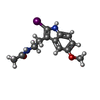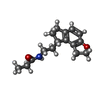+Search query
-Structure paper
| Title | Structural basis of the ligand binding and signaling mechanism of melatonin receptors. |
|---|---|
| Journal, issue, pages | Nat Commun, Vol. 13, Issue 1, Page 454, Year 2022 |
| Publish date | Jan 24, 2022 |
 Authors Authors | Qinggong Wang / Qiuyuan Lu / Qiong Guo / Maikun Teng / Qingguo Gong / Xu Li / Yang Du / Zheng Liu / Yuyong Tao /  |
| PubMed Abstract | Melatonin receptors (MT and MT in humans) are family A G protein-coupled receptors that respond to the neurohormone melatonin to regulate circadian rhythm and sleep. Numerous efforts have been made ...Melatonin receptors (MT and MT in humans) are family A G protein-coupled receptors that respond to the neurohormone melatonin to regulate circadian rhythm and sleep. Numerous efforts have been made to develop drugs targeting melatonin receptors for the treatment of insomnia, circadian rhythm disorder, and cancer. However, designing subtype-selective melatonergic drugs remains challenging. Here, we report the cryo-EM structures of the MT-G signaling complex with 2-iodomelatonin and ramelteon and the MT-G signaling complex with ramelteon. These structures, together with the reported functional data, reveal that although MT and MT possess highly similar orthosteric ligand-binding pockets, they also display distinctive features that could be targeted to design subtype-selective drugs. The unique structural motifs in MT and MT mediate structural rearrangements with a particularly wide opening on the cytoplasmic side. G is engaged in the receptor core shared by MT and MT and presents a conformation deviating from those in other G complexes. Together, our results provide new clues for designing melatonergic drugs and further insights into understanding the G protein coupling mechanism. |
 External links External links |  Nat Commun / Nat Commun /  PubMed:35075127 / PubMed:35075127 /  PubMed Central PubMed Central |
| Methods | EM (single particle) |
| Resolution | 3.1 - 3.46 Å |
| Structure data | EMDB-31980, PDB-7vgy: EMDB-31981, PDB-7vgz: EMDB-31982, PDB-7vh0: |
| Chemicals |  ChemComp-CLR:  ChemComp-ML2:  ChemComp-JEV: |
| Source |
|
 Keywords Keywords | MEMBRANE PROTEIN / G protein coupled receptor |
 Movie
Movie Controller
Controller Structure viewers
Structure viewers About Yorodumi Papers
About Yorodumi Papers









 homo sapiens (human)
homo sapiens (human)
